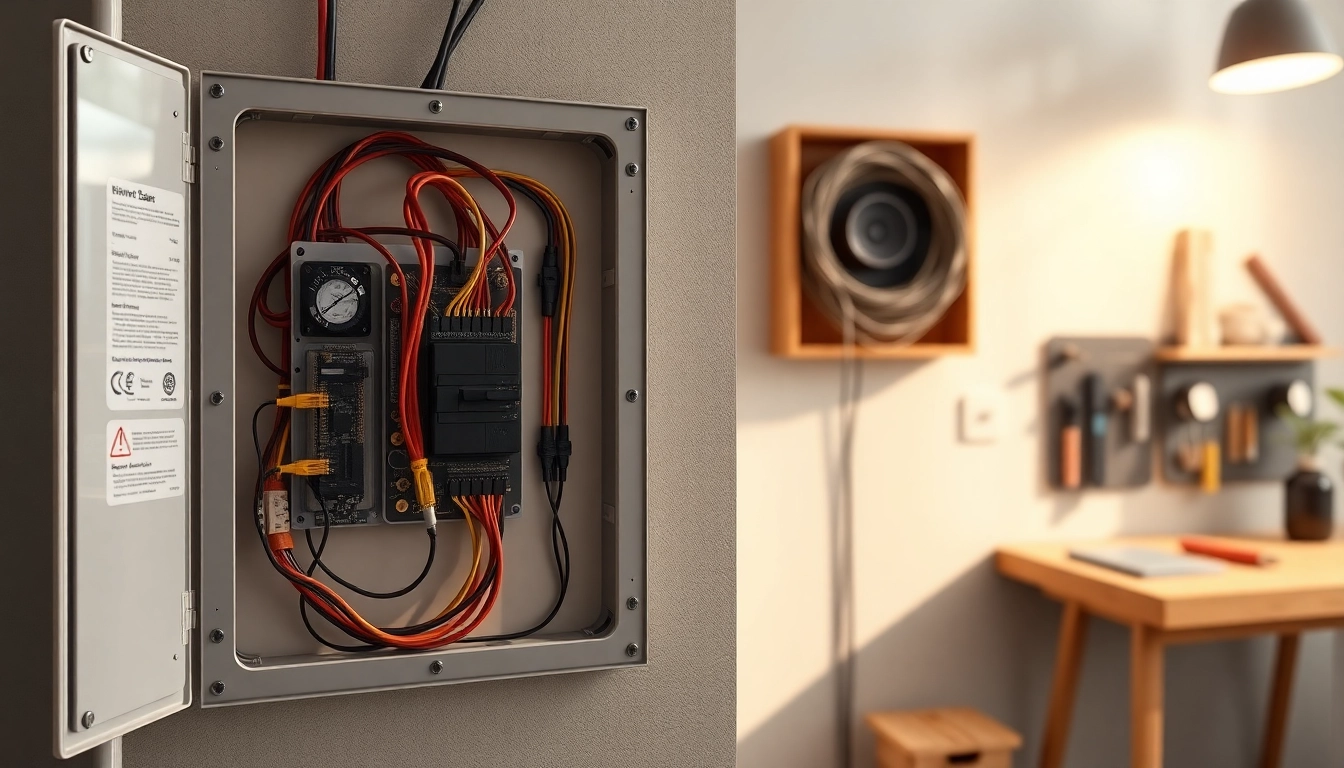Understanding Electrical Panels
What is an Electrical Panel?
An electrical panel, often referred to as a breaker box or distribution board, is a crucial component of a building’s electrical system. It serves as the central hub where electrical power is distributed from the main service line to various circuits within the home or business. The panel houses circuit breakers, which provide overcurrent protection to electrical circuits and allow for the safe management of electricity.
Electrical panels come in various configurations and capacities, suited to meet the electrical demands of different homes and businesses. Understanding the structure and operation of an electrical panel is essential for any homeowner or property manager, as it impacts safety, efficiency, and compliance with electrical codes.
The Function of Electrical Panels in Homes
At its core, the primary function of an electrical panel is to distribute electricity to different parts of a building. When electricity enters from the utility company, it flows through the meter and into the electrical panel. Here, it is divided into multiple circuits that power different areas or appliances. Each circuit is equipped with a breaker that can be tripped in case of an overload or fault, preventing potential fire hazards and damage to electrical equipment.
Moreover, modern electrical panels are designed to protect against electrical faults by utilizing Ground Fault Circuit Interrupters (GFCIs) and Arc Fault Circuit Interrupters (AFCIs). These devices enhance safety, particularly in moisture-prone areas like kitchens and bathrooms, where electrical shock risks are higher.
Common Types of Electrical Panels
There are several types of electrical panels, each designed for specific applications and load requirements. Understanding the differences can help homeowners make informed decisions regarding upgrades or replacements:
- Main Breaker Panels: The most common type found in households, these panels contain a main breaker that can shut power to the entire home.
- Sub Panels: Used in larger homes or buildings, sub panels distribute power to specific areas and reduce the load on the main panel.
- Combination Panels: These panels include both the main circuit breaker and various individual circuit breakers, offering a comprehensive solution.
- Service Entrance Panels: These indicate where electricity enters the home, typically equipped with a main disconnect and several branch circuit breakers.
Signs You Need to Upgrade Your Electrical Panel
Frequent Circuit Breaker Trips
One of the most telling signs that it may be time to upgrade your electrical panel is frequent circuit breaker trips. If you find yourself resetting breakers regularly, it indicates that your panel may not be able to handle the electrical load. This can occur due to outdated technology or an insufficient capacity for modern appliances and technology.
Regularly tripping breakers not only frustrates homeowners but also poses safety risks. Additionally, consistently using the same circuit can lead to overheating wiring, which may result in electrical fires.
Insufficient Power for Your Needs
As households evolve, their electrical needs often grow as well. With the increased use of electronic devices, smart home technology, and larger appliances like air conditioning units and electric vehicle chargers, your current electrical panel may be inadequate to meet these demands. If you’re frequently plugging in multiple devices and using extension cords, it’s a clear indication that your panel needs an upgrade.
A home energy audit can help identify your electrical usage and determine if your current panel meets your needs. Experts typically recommend a minimum of a 200-amp service for modern homes to accommodate the additional load of contemporary lifestyles.
Age and Condition of Your Current Panel
Electrical panels aren’t designed to last forever. Most panels have an operational lifespan of 25 to 40 years. If your panel is approaching or exceeding this age, it is vital to assess its condition. Signs of wear and tear, rust, or physical damage may indicate that the panel is no longer safe or efficient. Furthermore, older panels often do not comply with current electrical codes, making upgrading a necessary safety measure.
Investing in a replacement could enhance the safety and efficiency of a home’s electrical system and protect against issues that could arise from outdated technology.
Benefits of Upgrading Your Electrical Panel
Enhanced Safety and Compliance
One of the most significant benefits of upgrading your electrical panel is improved safety. Newer panels are designed with updated technology, which includes better surge protection, ground fault circuit interrupters, and enhanced circuit breakers. These features reduce the risk of electrical shock, fire, and property damage.
Additionally, modern panels adhere to the latest electrical codes enforced by various municipalities. Upgrading ensures compliance with safety regulations, which can be vital if you plan on selling your property in the future. Home inspectors typically look for outdated electrical panels as red flags during real estate transactions.
Improved Electrical System Performance
Upgrading to a new panel can significantly improve the overall performance of your electrical system. Newer panels often support higher amperage, allowing for more devices while minimizing the risk of overloads. This improved performance is particularly beneficial for homes that rely on advanced technology and multiple electrical appliances simultaneously.
Additional advantages include on-demand energy management features that help monitor and allocate power usage intelligently. Smart electrical panels can also provide data that helps you track your overall electricity consumption, thus assisting homeowners in making informed decisions about energy use and savings.
Increased Property Value
Investing in an upgraded electrical panel can yield returns in the form of increased property value. Prospective buyers often prioritize properties with modern electrical systems that conform to recent standards. A new panel indicates minimal future electrical work, reassuring buyers about the property’s overall safety and functionality.
Upgrading your electrical system may seem like a costly repair, but it can enhance the marketability of your home, making it more appealing than comparable properties with outdated electrical setups.
Choosing the Right Electrical Panel
Understanding Amperage Requirements
Determining your amperage requirements is essential before selecting a new electrical panel. Most homes benefit from a 200-amp service, allowing sufficient power to operate modern appliances safely without creating load issues. However, larger homes or those equipped with multiple high-demand appliances may require panels rated for 400 amps or more.
When assessing which panel meets your needs, consider factors such as the number of available circuits, the amperage of existing devices, and any foreseeable changes in electrical demand. Collaborating with a licensed electrician can provide clarity on your home’s specific requirements.
Comparing Panel Brands and Features
Not all electrical panels are created equal, and homeowners should recognize the benefits associated with various brands. Market leaders such as Square D, Siemens, and Eaton consistently receive high credibility due to their reliable performance and superior quality.
When comparing different panels, evaluate factors such as ease of installation, repair costs, warranty options, and the availability of replacement parts. In addition, look for features that may enhance performance, such as smart technology integration or enhanced safety functions.
Consulting with a Licensed Electrician
One of the most crucial steps in selecting and installing a new electrical panel is consulting with a licensed electrician. Their expertise can guide you through the complexities of panel selection, regulatory compliance, and installation practices, ensuring that your upgrade adheres to local codes and safety standards. They can conduct a thorough assessment of your electrical system and recommend the best solutions based on your specific needs.
Engaging with a professional also means they can handle all necessary permits and inspections, simplify the transition process, and address any potential challenges that may arise during installation.
Cost Considerations for Upgrading Your Electrical Panel
Factors Affecting the Cost of Upgrades
The cost of upgrading an electrical panel can vary significantly based on several factors, including panel type, complexity of installation, and your geographical location. The amp rating of the panel is another essential cost factor, with higher amp ratings typically translating to higher prices. Moreover, if any electric service lines need upgrading or if extensive wiring modifications are needed, this can add to the installation costs.
Homeowners should also consider potential bureaucratic requirements, such as permit fees, which can influence the overall budget for the upgrade.
Estimating Installation and Material Costs
In general, upgrading an electrical panel can range from $1,200 to $2,500, depending on the factors mentioned above. This estimate typically includes the cost of the new panel, materials, labor, and permits. For straightforward replacements with minimal additional work, costs may fall towards the lower end of the spectrum.
Homeowners should receive detailed estimates from contractors to understand better and anticipate the overall costs before proceeding with the work.
Potential Savings from Modern Panels
While the upfront costs of upgrading an electrical panel can seem substantial, newer modern panels can lead to long-term savings. Improved energy efficiency can lead to lower monthly utility bills, as advanced panels often optimize power distribution more effectively than older models. Some smart panels are designed to provide real-time data on energy consumption, enabling homeowners to make informed decisions that may lead to increased savings.
Furthermore, investing in a modern system can reduce the likelihood of electrical repairs and the associated costs, translating into additional savings over time.



